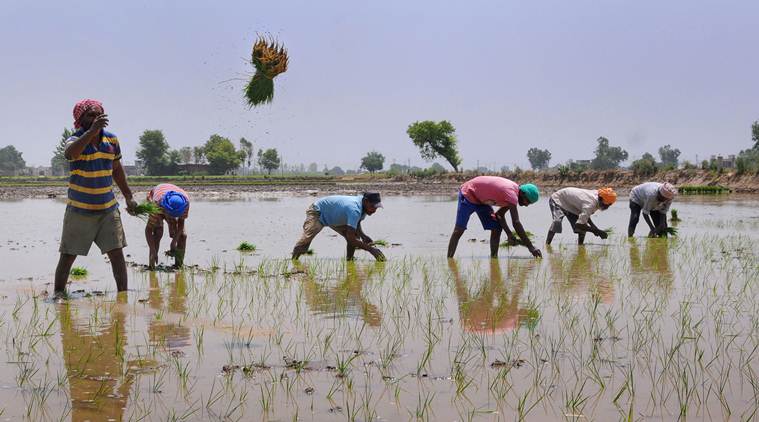 As part of the state’s ‘Mera Pani Meri Virasat’ scheme, the government wants to first diversify around 1 lakh hectare area, currently under paddy, to other crops such as maize and pulses. (PTI Photo)
As part of the state’s ‘Mera Pani Meri Virasat’ scheme, the government wants to first diversify around 1 lakh hectare area, currently under paddy, to other crops such as maize and pulses. (PTI Photo)
“I earn at least Rs 60,000 per acre from paddy per season. An incentive of Rs 7,000 offered by the government in lieu of diversification is not enough for the livelihood of our family,” says Danrshan Singh, a farmer from Digoh village of Ratia block (Fatehabad).
Ratia is one among 19 blocks of Haryana where the depth of groundwater exceeds 40 metres and “where the farmers have to diversify at least 50 per cent of their paddy area by growing alternate crops (maize, cotton, bajra, pulses)”. The state has 140 blocks.
The move is part of state’s ‘Mera Pani Meri Virasat’ scheme, wherein the government wants to first diversify around 1 lakh hectare area, currently under paddy, to other crops such as maize and pulses.
However, decision has not gone down well with farmers who have planned protests in different parts of the state. Senior Congress leaders Kumari Selja and Randeep Singh Surjewala have termed government’s decision as a “tuglaqi farmaan”.
Farmer Darshan Singh cultivates paddy in 30 acres of land. “We don’t have any other option. The area is not suitable for cotton. We can grow sugarcane, but the nearest sugar mill at Bhuna is not functional,” says Darshan Singh. Echoing similar sentiments another farmer Sukhdeep Randhawa says, “Our area is prone to floods, so we can’t sow pulses and maize here.”
The government has promised that the alternative crops will be procured by government agencies but the farmers say they have faced difficulties in selling their produce in the past. A farm activist from Ratia, Sukhdeep Nathwan says, “The farmers may not get even Rs 7,000 per acre because government has imposed several conditions. Last year, we were promised an incentive of Rs 2,000 per acre in lieu of processing paddy stubble instead of burning it but that money never reached the farmers.”
Mandeep, who has been cultivating paddy in 11 acres, says they have formed “Kheti Bachao Committee” to oppose the government’s new decision.
A farmer from Shahabad of Kurukshetra district, Rakesh Bains, says, “There is no clarity when Rs 7,000 will be given to the farmers. We have heard that initially only 25 per cent of the amount will be given to the farmers, that too for the premium of ‘Pradhan Mantri Fasal Bima Yojana’. The government’s decision to restrict the paddy area to half will reduce the income of farmers by half,” says Bains.
Bhartiya Kisan Union’s Haryana unit president Gurnam Singh Chaduni says, “If the government was really serious on the water table issue, then it should not have closed Dadupur Nalvi Canal. Further, how the crops (maize, cotton, bajra or pulses) suggested by the government as an alternative to the paddy can be grown in those areas which are normally flooded by seasonal rivers like Dagri and Markanda?”
Meanwhile, Surjewala, who had termed the move as “tuglaqi farmaan”, says , “The government has not only asked the farmers to compulsorily switch to other crops without offering them a better option, it has also threatened them that all the farm subsidies would be taken away and there would not be any procurement of paddy.”
Last year, according to Surjewala, the Khattar government had started a ‘Jal Hi Jeevan Hai’ scheme in which seven different blocks were identified where the crop pattern was to be changed from paddy to maize on 1.37 lakh acres.
“The farmers were promised an incentive of Rs 2,000 per acre, Rs 766 per acre for insurance premium and maize hybrid seeds, but the truth is that no such compensation has been given till today. Let the CM come forward and inform the state as to how much compensation was given and how much of hybrid seeds given. The truth is that the conversion from paddy to maize cultivation did not happen and that is why CM is now experimenting with life and livelihood of farmers in other blocks.”
Chaduni claims that the maize hybrid seeds had failed in producing desired results last year.
On his part, the CM Manohar Lal Khattar, while launching the new scheme, had stated that some 36 blocks are now in dark zone where rate of depletion of ground water level has doubled in the last 12 years. “It means that where the ground water level was earlier at 20 meters, it has now further depleted to 40 meters. There are 19 such blocks, where the water depth has exceeded 40 meters,” he had said. However, out of these 19, there are 11 blocks in which paddy is not sown. He informed that eight paddy-rich blocks including Ratia, Siwan, Guhla, Pipli, Shahabad, Babain, Ismailabad and Sirsa, where the depth of ground water level exceeds 40 meters, would be included in this scheme.